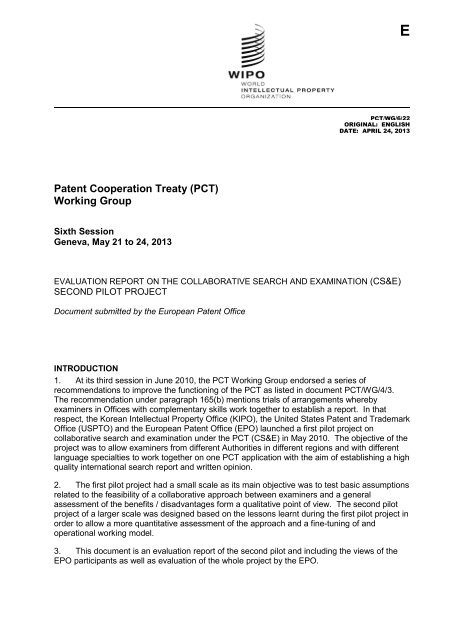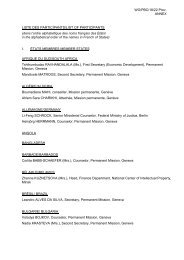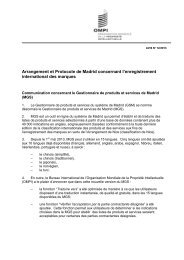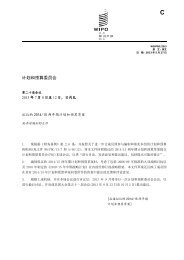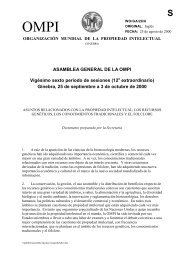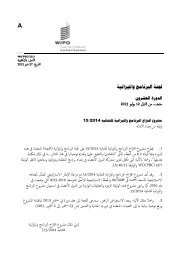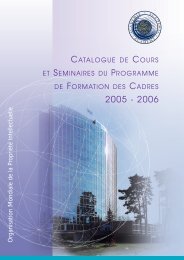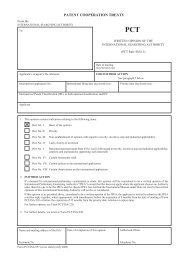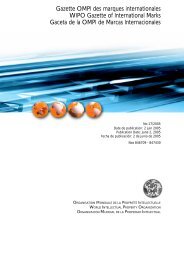Patent Cooperation Treaty (PCT) Working Group - WIPO
Patent Cooperation Treaty (PCT) Working Group - WIPO
Patent Cooperation Treaty (PCT) Working Group - WIPO
Create successful ePaper yourself
Turn your PDF publications into a flip-book with our unique Google optimized e-Paper software.
E<strong>PCT</strong>/WG/6/22ORIGINAL: ENGLISHDATE: APRIL 24, 2013<strong>Patent</strong> <strong>Cooperation</strong> <strong>Treaty</strong> (<strong>PCT</strong>)<strong>Working</strong> <strong>Group</strong>Sixth SessionGeneva, May 21 to 24, 2013EVALUATION REPORT ON THE COLLABORATIVE SEARCH AND EXAMINATION (CS&E)SECOND PILOT PROJECTDocument submitted by the European <strong>Patent</strong> OfficeINTRODUCTION1. At its third session in June 2010, the <strong>PCT</strong> <strong>Working</strong> <strong>Group</strong> endorsed a series ofrecommendations to improve the functioning of the <strong>PCT</strong> as listed in document <strong>PCT</strong>/WG/4/3.The recommendation under paragraph 165(b) mentions trials of arrangements wherebyexaminers in Offices with complementary skills work together to establish a report. In thatrespect, the Korean Intellectual Property Office (KIPO), the United States <strong>Patent</strong> and TrademarkOffice (USPTO) and the European <strong>Patent</strong> Office (EPO) launched a first pilot project oncollaborative search and examination under the <strong>PCT</strong> (CS&E) in May 2010. The objective of theproject was to allow examiners from different Authorities in different regions and with differentlanguage specialties to work together on one <strong>PCT</strong> application with the aim of establishing a highquality international search report and written opinion.2. The first pilot project had a small scale as its main objective was to test basic assumptionsrelated to the feasibility of a collaborative approach between examiners and a generalassessment of the benefits / disadvantages form a qualitative point of view. The second pilotproject of a larger scale was designed based on the lessons learnt during the first pilot project inorder to allow a more quantitative assessment of the approach and a fine-tuning of andoperational working model.3. This document is an evaluation report of the second pilot and including the views of theEPO participants as well as evaluation of the whole project by the EPO.
<strong>PCT</strong>/WG/6/22page 24. The second pilot project was concluded in October 2012 with a very encouraging result.This document provides an evaluation of the second pilot by the EPO.BUILDING ON THE FIRST PILOT PROJECT5. The main conclusions for the first pilot project were:• CS&E is a realistic concept;• the collaboration between examiners brings a clear added-value regarding the qualityof the ISR and WO-ISA; as a consequence, legal certainly increases;• no major additional time investment would be required in regional/national phase as aresult of the collaboration in the international phase.6. Based on these main conclusions from the limited scale first pilot, the Offices KIPO,USPTO and EPO decided to launch the second pilot with duration of one year and involvingmore examiners and more <strong>PCT</strong> applications. The size of this second pilot was as follows:• eight examiners per participating Office, with a total of 24 examiners involved in thepilot;• each examiner treating a total of eight <strong>PCT</strong> applications as first examiner (responsiblefor the applications; see Annex I) and collaborating in other 16 <strong>PCT</strong> applications of thetwo counterparts;• the targeted total number of <strong>PCT</strong> applications treated in the pilot was 192 (each Officetreating 64 <strong>PCT</strong> applications as ISA and collaborating in another 128).7. The second pilot was split in two parts: A first part was conducted from October 2011 toMarch 2012 with four <strong>PCT</strong> applications per examiner acting as first examiner. The second partwas conducted from April to September 2012 with four additional <strong>PCT</strong> applications perexaminer acting as first examiner.OBJECTIVES FOR THE SECOND PILOT PROJECT8. The objectives of the CS&E pilot were:(a) To define the conditions under which examiners of different ISAs in different regionscan co-produce the ISR and the WO-ISA for <strong>PCT</strong> applications. This includes testing thefined-tuned methodology to identify how collaboration could be implemented in anoperational environment in a wider deployment within the Offices.(b) To evaluate from a qualitative and quantitative point of view the benefits anddisadvantages of the collaborative approach in terms of quality and efficiency. Theapproach towards measuring the quality and efficiency effects of collaborating in theproduction of the ISR and WO-ISA is explained in Annex II.PILOT DESIGN9. The pilot was designed for testing the concept of collaborative search and examinationaccording to the objectives set forth in paragraph 8 above. Arrangements for testing otherobjectives, such as improvement of the ISA timeliness or mastering <strong>PCT</strong> workloads should bekept outside of the scope of the CS&E pilot.
KIPO FEEDBACK29. KIPO also provided feedback to the EPO on the results of the second CS&E pilots.Similar as in the EPO by the time of pilot closure and report preparation, not all CS&Eapplications were completed.<strong>PCT</strong>/WG/6/22page 630. Due to the organization of the pilot, it was not practicable for the KIPO to provide feedbackon additional time needed for treating a CS&E application.31. KIPO examiners acting as first examiners evaluated that in 77 per cent of the applications,the feedback received included additional citations found by the peer examiners. The feedbackreceived by the first examiner was rated as relevant in 75 per cent of the applications treated.In only 2 per cent of the applications, the feedback was found to be not relevant at all. In 71 percent of the applications, the feedback resulted in citations added by the first examiner to thefinal search report (ISR). In 46 per cent of the applications, the feedback resulted inamendments to the WO-ISA. In 92 per cent of the cases, first examiners perceived the finalproduct (final ISR and WO-ISA) improved as a result of collaboration with peer examiners.KIPO examiners acting as peer examiners essentially confirmed the findings of the EPOexaminers acting as peer examiners. The quality of the final product was increased by thecollaboration in nearly all cases. For approximately half of the pilot application KIPO examinersperformed an additional search or citations were added to the search report.32. There was one outcome in the KIPO that was substantially different to the EPO'sobservations. Namely, in case KIPO was not the ISA, the trust in the final product obtained incollaborative matter was substantially lower than this of the EPO. In only 29 per cent of suchcases KIPO examiners would trust the collaborative results. In addition, in 55 per cent of casesa little time would be needed for a complementary search in the regional phase.33. In the EPO in only 2 per cent of cases an additional search would have to be performed inthe regional phase. This difference 2 per cent vs. 55 per cent may suggest that themethodology and principles of the CS&E pilot were applied differently in the EPO and KIPO. Inthe EPO examiners were instructed, in accordance with the project methodology, to provide aspeer examiners contribution to such an extent that the final CS&E product could be directlytrusted and reusable in the subsequent regional phase. On this basis only meaningful costestimation is possible.34. We need to clarify what is the rationale behind the significant difference in the perceptionof the results. It is also not clear why in KIPO still substantial effort would be required in theregional phase.USPTO FEEDBACK35. USPTO feedback is still in evaluation phase. USPTO contribution is essential before beingable to draw final conclusions on the pilot.CONCLUSION36. The perception of the EPO examiners was that all <strong>PCT</strong> Chapter I final products preparedin the collaborative manner were directly usable in the regional/national phase with someadditional administrative work (adapting legal reference or re-formulating reasoning).Collaboration between examiners for obtaining a collaborative search report and opinion in theway proposed by CS&E is a very promising initiative widely supported by industry and patentinstitutions.
<strong>PCT</strong>/WG/6/22page 737. Based on the signals and reports received from other IP5 Offices and the need to carefullyanalyze the political implications, it seems to be still too early to propose at this stage apermanent CS&E scheme. Discussions are ongoing to further explore this concept by initiatinga third pilot. However, replicating pilots 1 and 2 into a third pilot is not really meaningful. It istherefore proposed to launch a third pilot which would be this time applicant driven.38. It is important to underline that the objective of the Collaborative Search & Examinationproject is to obtain a product, which could be directly usable in the participating Offices whenentering the regional phase. It is clear that applicants opting for a Collaborative Search &Examination would do this with mind of entering into regional phase in the participating Offices.Therefore the concept of CS&E is an implementation of the work sharing policies of the IP5(e.g. as discussed in IP5 and consistent and fully aligned with <strong>WIPO</strong> <strong>PCT</strong>-RO)39. Taking into the overall process (international and regional phases) substantial savings canbe expected based on the assumption that applicants opting for CS&E seriously considerentering into regional phase of the participating Office.40. In this respect information from KIPO and USPTO is required as to whether this wouldalso be the case in the respective Offices as primary feedback received from these two Officesis somehow contradictory.41. Concerning the voiced timeliness issue, indeed it has been an issue in the two pilotsmainly because it has been opted on published <strong>PCT</strong> applications, for obvious legal reasons andthe data workflow between Offices was purely manual as well as intensive feedback andmonitoring procedure was applied.42. Should there be a third pilot as proposed then the applicants would indicate which <strong>PCT</strong>applications should be treated in a collaborative manner. Therefore, waiting for publicationwould not be necessary. Also, IT tools supporting data exchange would need to be established.Concerning the cost, primary indication on time required for processing a CS&E InternationalSearch Report seems to be approximately 150 per cent of the time required for Chapter I EPOalone.43. EPO evaluation of the second pilot tend to show that CS&E could be an efficient workscheme leading to time saving solution rather than cause for additional workload. This is basednot only on the fact that added value is expected, but mainly on EPO's perception on reusabilityand efficiency increase as to avoid work duplication.44. The <strong>Working</strong> <strong>Group</strong> is invited tonote the contents of this document.[Annexes follow]
<strong>PCT</strong>/WG/6/22ANNEX IPILOT METHODOLOGYExaminers participating in this pilot used the following methodology:1. The examiner of the Office acting as ISA for a given <strong>PCT</strong> application (called firstexaminer) analyzes the application in order to understand it. The first examiner will work on thisapplication as for any other <strong>PCT</strong> application by preparing a search strategy (what to search,where to search and how to search) and conducting the search and examination accordingly.As a result, the first examiner will establish a provisional ISR and WO-ISA. This provisionalwork should then be transmitted to the peer examiners in the other participating Offices (calledpeers). In addition to the provisional ISR and WO-ISA, the first examiner should make availableto the peers his/her provisional RoSS. The first examiner will use the standard template for theRoSS (Record of Search Strategy) adapted to the needs of the corresponding technical field.2. The delivery of the provisional ISR and WO-ISA triggers a time limit for the peerexaminers of one week to provide feedback. The peers are expected to comment on orcomplement as appropriate the provisional work of the first examiner within one week. Thecomments by the peers could be related to the citations, the WO-ISA or the search strategy andwill be sent using the standard template for the feedback form. Complementing the searchwould mean providing additional search results or examination findings to the first examiner. If apeer examiner decides to complement the search the information about the RoSS for theadditional search will be included in the feedback from.3. The time needed for the peers' contribution will be assessed by each Office under theassumption that the contribution should provide added value to the work of the first examiner. Itis therefore expected that the feedback will be in general more substantial than a simplestatement indicating that there are no comments.4. There could be more than one exchange of information between the first examiner andany of the peer examiners. For any exchange a time limit of one week also applies to thereception of feedback, either from the peer examiner of the first examiner.5. After reception of the feedback from the peer examiners the first examiner will proceedwith the establishment of a final ISR and WO-ISA. This should be done not later than one weekafter reception of the last feedback. The final ISR and WO-ISA will be transmitted to theapplicant on behalf of the ISA accompanied by a standard letter that informs that the applicationhas being treated under the CS&E pilot.6. The final ISR and WO-ISA (consolidated ISR and WO-ISA) will be the result ofcomplementing the provisional ISR WO-ISA (the one drafted by the first examiner before havingany feedback) with the comments received from the peers. A consolidated RoSS (provisionalsearch strategy drafted by the first examiner + feedback from the peers) will be drafted by thefirst examiner and kept in the file.7. The first examiner will make available to the peers a copy of the final ISR and WO-ISA aswell as the consolidated search strategy when these are sent to the applicant.8. The final ISR will be as complete as possible by including all citations, i.e. those found bythe first examiner and those provided by the peer examiners. The WO-ISA will also be ascomplete as possible by including the argumentations provided by the peer examinerswhenever these are complementary and not contradictory. In the case of the WO-ISA, theargumentations are to be preceded by a standard sentence to help applicants understand theseadditional argumentations where appropriate.[Annex II follows]


